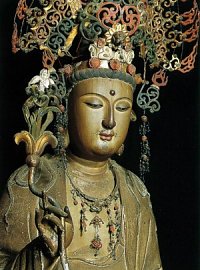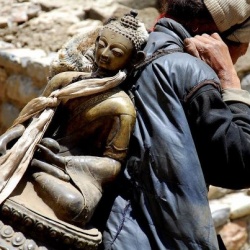Difference between revisions of "Abhidharmakoša and Analysis of Existence"
(Created page with " <poem> Abhidharmakoša and Analysis of Existence Vasubandhu in his treatise “Abhidharmakoša” defines that Abhidharma “is a pure knowledge togeth...") |
|||
| Line 1: | Line 1: | ||
| − | + | <nomobile>{{DisplayImages|298|2370|2670|2462|3864}}</nomobile> | |
| Line 5: | Line 5: | ||
[[Abhidharmakoša and Analysis of Existence]] | [[Abhidharmakoša and Analysis of Existence]] | ||
| − | [[Vasubandhu]] in his treatise | + | [[Vasubandhu]] in his treatise “[[Abhidharmakoša]]” defines that [[Abhidharma]] “is a [[pure]] [[knowledge]] together with accompanying [[dharmas]]”. |
| − | A “[[Pure | + | A “[[Pure Knowledge]]” is [[knowledge]] firstly about the [[highest]] [[dharma]], i.e. [[Nirvana]], secondly about [[dharmas]] with a meaning “[[elements]]” or “[[manifestations]] of [[elements]]” to which is divided all [[empirical]] [[existence]], all the [[existence]] we can [[experience]] or think of. |
| − | The “accompanying [[dharmas]]” are called those [[psychic]] and other [[elements]] that are inseparably connected with the goal of our [[contemplation]]. [[Thus]], [[Abhidharma]] stands for the sum of [[elements]] in which that part of the {{Wiki|individual}} [[life]] is expressed where he moves towards the [[essence]] of the things or those [[elements]] in which the tendency to the [[cessation]] of the [[empirical]] [[existence]] [[manifests]] itself | + | The “accompanying [[dharmas]]” are called those [[psychic]] and other [[elements]] that are inseparably connected with the goal of our [[contemplation]]. [[Thus]], [[Abhidharma]] stands for the sum of [[elements]] in which that part of the {{Wiki|individual}} [[life]] is expressed where he moves towards the [[essence]] of the things or those [[elements]] in which the tendency to the [[cessation]] of the [[empirical]] [[existence]] [[manifests]] itself. |
| − | You can say that in the deeper meaning, [[Abhidharma]] is a common [[name]] for the group of [[metaphysical]] [[elements]] that leads us to the dharma-Nirvana or dharmas-substrates. | + | Those [[elements]] are the tools by which the {{Wiki|salvation}} is [[attained]]. |
| + | |||
| + | You can say that in the deeper meaning, [[Abhidharma]] is a common [[name]] for the group of [[metaphysical]] [[elements]] that leads us to the dharma-Nirvana or [[dharmas]]-substrates. | ||
In the popular [[sense]] [[Abhidharma]] means “a notion” or “[[understanding]]” that leads towards [[contemplation]] about [[Nirvana]] or carriers (vessels). | In the popular [[sense]] [[Abhidharma]] means “a notion” or “[[understanding]]” that leads towards [[contemplation]] about [[Nirvana]] or carriers (vessels). | ||
| Line 17: | Line 19: | ||
The [[knowledge]] will be not “[[pure]]” if it will be [[empirically]] mixed with [[elements]] of [[anxiety]], i.e. those [[elements]] that constitute a [[personality]] and are uphold by the cycle of [[empirical]] [[existence]], but which are still tied with [[elements]] that lead towards a “[[pure]]” [[understanding]] or [[realizing]] of the [[essence]] of things. | The [[knowledge]] will be not “[[pure]]” if it will be [[empirically]] mixed with [[elements]] of [[anxiety]], i.e. those [[elements]] that constitute a [[personality]] and are uphold by the cycle of [[empirical]] [[existence]], but which are still tied with [[elements]] that lead towards a “[[pure]]” [[understanding]] or [[realizing]] of the [[essence]] of things. | ||
| − | Finally, [[Abhidharma]] is also a [[teaching]] and research that is telling about the “[[pure]] [[knowledge]]”, i.e. treatises that are able to create a “[[pure]] [[knowledge]]” in a [[person]]. This is the meaning why the [[third basket]] of the [[Tripitaka]] is called “[[Abhidharma]]”; as a {{Wiki|literature}} or a treatise about [[Nirvana]] and the [[elements]] accompanying it. | + | Finally, [[Abhidharma]] is also a [[teaching]] and research that is telling about the “[[pure]] [[knowledge]]”, i.e. treatises that are able to create a “[[pure]] [[knowledge]]” in a [[person]]. |
| + | |||
| + | This is the meaning why the [[third basket]] of the [[Tripitaka]] is called “[[Abhidharma]]”; as a {{Wiki|literature}} or a treatise about [[Nirvana]] and the [[elements]] accompanying it. | ||
So the content of the [[Abhidharmic]] {{Wiki|literature}} is the content of [[existence]]; the [[elements of existence]], the laws which holds them together, etc. And the goal of [[being]] is [[Nirvana]], the [[element]] of [[cessation]]. | So the content of the [[Abhidharmic]] {{Wiki|literature}} is the content of [[existence]]; the [[elements of existence]], the laws which holds them together, etc. And the goal of [[being]] is [[Nirvana]], the [[element]] of [[cessation]]. | ||
| Line 23: | Line 27: | ||
We can say that the first [[basket]] of the [[Pali Canon]] contains the [[doctrine]] of [[experience]], the second – the [[doctrine]] of {{Wiki|salvation}}. Both parts are connected very tight and together are creating one system, the [[dharma]] {{Wiki|theory}}, to which is reduced the [[Buddhist teaching]]. [[Abhidharmic]] {{Wiki|literature}} encompasses the {{Wiki|ontology}} and [[metaphysics]] which is grounded on the [[psychological]] analysis of the [[knowledge]]. | We can say that the first [[basket]] of the [[Pali Canon]] contains the [[doctrine]] of [[experience]], the second – the [[doctrine]] of {{Wiki|salvation}}. Both parts are connected very tight and together are creating one system, the [[dharma]] {{Wiki|theory}}, to which is reduced the [[Buddhist teaching]]. [[Abhidharmic]] {{Wiki|literature}} encompasses the {{Wiki|ontology}} and [[metaphysics]] which is grounded on the [[psychological]] analysis of the [[knowledge]]. | ||
| − | + | The studies of the [[Abhidharmic]] {{Wiki|literature}} and the {{Wiki|theory}} of the [[dharmas]] usually begin with research of the “Abhidharmakoša” by [[Vasubandhu]], which serves as an authority for all contemporary studies. | |
| − | [[Buddhist scholars]] explain the {{Wiki|theory}} about [[dharmas]] in a very carefully defined {{Wiki|terminology}}, which gives an opportunity to describe very precisely the observations of the [[phenomena]] of the [[knowledge]] and [[experience]]. Significant roles in the [[Buddhist philosophy]] are playing numerical {{Wiki|expressions}} that serve as a tool to shorten the description as much as possible. Statements like “5 groups”, “12 bases”, “18 [[elements]]” and many others are well known and widely accepted {{Wiki|expressions}} in the [[Buddhist literature]]. They completely replace the repeating of all [[elements]] included in each {{Wiki|classification}}. | + | [[Buddhist scholars]] explain the {{Wiki|theory}} about [[dharmas]] in a very carefully defined {{Wiki|terminology}}, which gives an opportunity to describe very precisely the observations of the [[phenomena]] of the [[knowledge]] and [[experience]]. |
| + | |||
| + | Significant roles in the [[Buddhist philosophy]] are playing numerical {{Wiki|expressions}} that serve as a tool to shorten the description as much as possible. | ||
| + | |||
| + | Statements like “5 groups”, “12 bases”, “18 [[elements]]” and many others are well known and widely accepted {{Wiki|expressions}} in the [[Buddhist literature]]. | ||
| + | |||
| + | They completely replace the repeating of all [[elements]] included in each {{Wiki|classification}}. | ||
In all three types of [[dharma]] {{Wiki|classification}} the analysed [[object]] is the same – the flow of an {{Wiki|individual}} [[life]] (or “[[santana]]”), [[elements]] of which, according to the [[tradition]], [[Buddha]] himself has classified in 3 ways: | In all three types of [[dharma]] {{Wiki|classification}} the analysed [[object]] is the same – the flow of an {{Wiki|individual}} [[life]] (or “[[santana]]”), [[elements]] of which, according to the [[tradition]], [[Buddha]] himself has classified in 3 ways: | ||
| Line 33: | Line 43: | ||
18 [[Elements]] (“[[dhātu]]”) | 18 [[Elements]] (“[[dhātu]]”) | ||
| − | The systematic [[philosophy]] in [[India]] started on with analysis and observations of the [[personality]]. To explain it, first of all the [[human]] [[personality]] was analysed instead of external [[phenomena]]. But because the [[human]] [[Wikipedia:Psyche (psychology)|psyche]] seems to be connected with [[material body]], it is analysed as well. This way the [[human]] [[material body]] and its [[psychic]] content were divided to the smallest {{Wiki|particles}}, [[elements]]. | + | The systematic [[philosophy]] in [[India]] started on with analysis and observations of the [[personality]]. To explain it, first of all the [[human]] [[personality]] was analysed instead of external [[phenomena]]. |
| + | |||
| + | But because the [[human]] [[Wikipedia:Psyche (psychology)|psyche]] seems to be connected with [[material body]], it is analysed as well. This way the [[human]] [[material body]] and its [[psychic]] content were divided to the smallest {{Wiki|particles}}, [[elements]]. | ||
| + | |||
| + | In another, [[psychological]] analysis of the [[Buddhist scholars]], the [[personality]] is seen as consisting from a [[consciousness]] altogether with the [[experience]] of its [[psychic]] content and the [[experience]] of the external [[phenomena]] in the [[mind]], when the so called [[objective world]] becomes a part of the [[personality]]. | ||
| + | |||
| + | In [[Buddhist]] [[discourses]] on [[dharma]] {{Wiki|theory}} you can mostly find the second approach. | ||
| − | + | But the analysis of the [[conscious]] [[personality]], analysis of the [[consciousness]] and its content, nowadays is considered an [[object]] of {{Wiki|psychology}}. For this [[reason]] we could say the starting point of the [[dharma]] {{Wiki|theory}} is a [[psychological]] research of a [[human]] [[personality]]. | |
</poem> | </poem> | ||
{{R}} | {{R}} | ||
Revision as of 09:51, 26 October 2015
Abhidharmakoša and Analysis of Existence
Vasubandhu in his treatise “Abhidharmakoša” defines that Abhidharma “is a pure knowledge together with accompanying dharmas”.
A “Pure Knowledge” is knowledge firstly about the highest dharma, i.e. Nirvana, secondly about dharmas with a meaning “elements” or “manifestations of elements” to which is divided all empirical existence, all the existence we can experience or think of.
The “accompanying dharmas” are called those psychic and other elements that are inseparably connected with the goal of our contemplation. Thus, Abhidharma stands for the sum of elements in which that part of the individual life is expressed where he moves towards the essence of the things or those elements in which the tendency to the cessation of the empirical existence manifests itself.
Those elements are the tools by which the salvation is attained.
You can say that in the deeper meaning, Abhidharma is a common name for the group of metaphysical elements that leads us to the dharma-Nirvana or dharmas-substrates.
In the popular sense Abhidharma means “a notion” or “understanding” that leads towards contemplation about Nirvana or carriers (vessels).
The knowledge will be not “pure” if it will be empirically mixed with elements of anxiety, i.e. those elements that constitute a personality and are uphold by the cycle of empirical existence, but which are still tied with elements that lead towards a “pure” understanding or realizing of the essence of things.
Finally, Abhidharma is also a teaching and research that is telling about the “pure knowledge”, i.e. treatises that are able to create a “pure knowledge” in a person.
This is the meaning why the third basket of the Tripitaka is called “Abhidharma”; as a literature or a treatise about Nirvana and the elements accompanying it.
So the content of the Abhidharmic literature is the content of existence; the elements of existence, the laws which holds them together, etc. And the goal of being is Nirvana, the element of cessation.
We can say that the first basket of the Pali Canon contains the doctrine of experience, the second – the doctrine of salvation. Both parts are connected very tight and together are creating one system, the dharma theory, to which is reduced the Buddhist teaching. Abhidharmic literature encompasses the ontology and metaphysics which is grounded on the psychological analysis of the knowledge.
The studies of the Abhidharmic literature and the theory of the dharmas usually begin with research of the “Abhidharmakoša” by Vasubandhu, which serves as an authority for all contemporary studies.
Buddhist scholars explain the theory about dharmas in a very carefully defined terminology, which gives an opportunity to describe very precisely the observations of the phenomena of the knowledge and experience.
Significant roles in the Buddhist philosophy are playing numerical expressions that serve as a tool to shorten the description as much as possible.
Statements like “5 groups”, “12 bases”, “18 elements” and many others are well known and widely accepted expressions in the Buddhist literature.
They completely replace the repeating of all elements included in each classification.
In all three types of dharma classification the analysed object is the same – the flow of an individual life (or “santana”), elements of which, according to the tradition, Buddha himself has classified in 3 ways:
5 Groups (“skandha”)
12 Bases (“āyatana”)
18 Elements (“dhātu”)
The systematic philosophy in India started on with analysis and observations of the personality. To explain it, first of all the human personality was analysed instead of external phenomena.
But because the human psyche seems to be connected with material body, it is analysed as well. This way the human material body and its psychic content were divided to the smallest particles, elements.
In another, psychological analysis of the Buddhist scholars, the personality is seen as consisting from a consciousness altogether with the experience of its psychic content and the experience of the external phenomena in the mind, when the so called objective world becomes a part of the personality.
In Buddhist discourses on dharma theory you can mostly find the second approach.
But the analysis of the conscious personality, analysis of the consciousness and its content, nowadays is considered an object of psychology. For this reason we could say the starting point of the dharma theory is a psychological research of a human personality.




